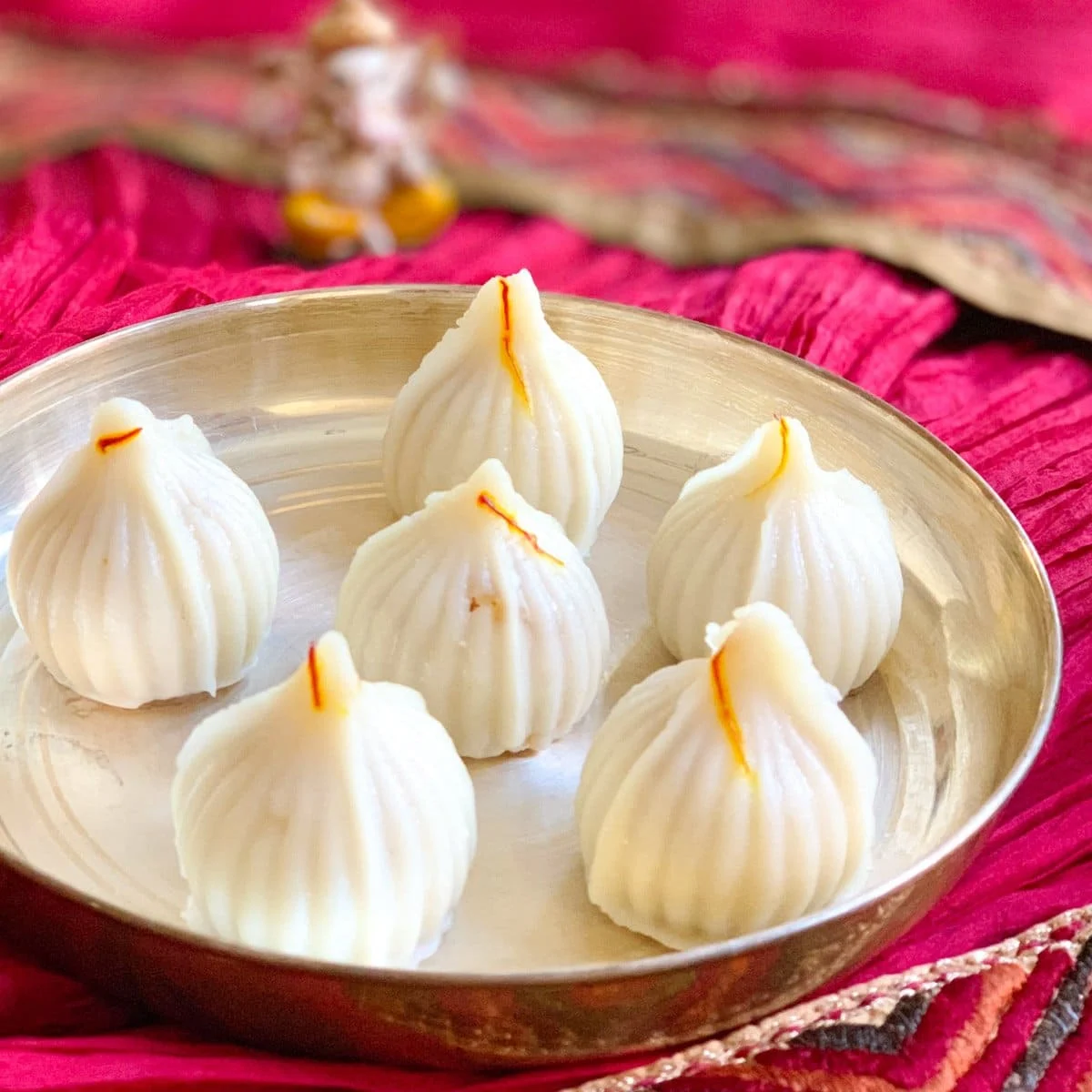A Sweet Dumpling Full of Devotion and Love
If you grew up in India, chances are the word modak instantly brings back memories of Ganesh Chaturthi celebrations—those ten days when homes smell of incense, laughter fills the air, and kitchens come alive with the sound of boiling rice flour and the sweet aroma of jaggery melting with coconut.
For many, modak isn’t just food—it’s an emotion. It’s the favorite sweet of Lord Ganesha, but also a treat that binds families together. Preparing modak is not a one-person job. It’s a family ritual. One person makes the filling, another works on the dough, and the most patient ones sit and shape those delicate little dumplings. By the end, everyone gathers near the steaming pot, waiting for the first batch to come out, hot and fragrant.
That’s the beauty of modak—it’s not only delicious but also deeply cultural, festive, and heartwarming. Let me take you step by step through the process of making the traditional Ukadiche Modak (the steamed version), and along the way, we’ll also talk about variations, tips, and the little secrets that make this sweet so beloved.
The Story and Significance of Modak
Before we jump into the kitchen, let’s talk about why modak is so special. According to Hindu mythology, Lord Ganesha—the remover of obstacles and the God of wisdom—absolutely loved modaks. Legends say that once he was served 21 modaks, and he enjoyed them so much that devotees ever since offer modaks in multiples of 21 as prasad.
During Ganesh Chaturthi, families make trays full of modaks as an offering. But even outside of festivals, modaks are a symbol of prosperity and happiness. Some households prepare them on auspicious occasions, weddings, or as a special treat in monsoon and winter seasons.
But here’s something beautiful: beyond devotion, modak-making is really about patience and love. They are delicate, time-consuming, and slightly tricky to shape. Yet families keep the tradition alive because food that requires effort often carries the sweetest memories.
Types of Modak
Though the classic steamed version is the most popular, you’ll find different varieties across India.
- Ukadiche Modak (Steamed Modak): The traditional Maharashtrian version made with rice flour dough and coconut-jaggery filling. Soft, pillowy, and melt-in-the-mouth.
- Tala Modak (Fried Modak): These are deep-fried, giving them a crunchy outer layer and a long shelf life. Perfect if you want them to last a few days.
- Chocolate Modak: A modern favorite, especially among kids. Melted chocolate or cocoa powder is mixed into the dough or filling.
- Mawa Modak: Made with khoya (milk solids), often shaped using moulds, rich and luxurious in taste.
- Dry Fruit Modak: Packed with nuts, dates, and figs—a healthier twist.
- Kesariya Modak: Flavored with saffron and cardamom, giving a royal golden touch.
But for today, we’ll make the star of the show—the traditional Ukadiche Modak. Once you master this, experimenting with other varieties becomes much easier.
Ingredients You’ll Need
Don’t worry—the list looks simple, and most items are probably already in your kitchen.
For the filling:
- 2 cups freshly grated coconut
- 1 cup jaggery (grated or powdered)
- 1 teaspoon cardamom powder
- A small pinch of nutmeg powder (optional, but adds fragrance)
- 1 teaspoon poppy seeds (optional, adds a light crunch)
- 1 teaspoon ghee (clarified butter)
For the dough:
- 1 cup fine rice flour (make sure it’s sieved and lump-free)
- 1 ¼ cup water
- 1 teaspoon ghee
- A tiny pinch of salt
For steaming:
- A steamer or idli pot
- Banana leaves or muslin cloth for lining (traditional, but optional)
Step-by-Step Method
Here’s where the fun begins. Making modak has two main parts: preparing the filling and making the rice flour dough. Once both are ready, we shape and steam.
Step 1: Preparing the Sweet Coconut-Jaggery Filling
This part is heavenly—the moment jaggery hits the pan, the entire kitchen fills with its warm, earthy aroma.
- Heat a pan and add 1 teaspoon ghee.
- Add the grated coconut and lightly roast it for 2–3 minutes on medium flame. Don’t let it brown—we just want to release its natural oils.
- Add jaggery and stir. It will melt and blend beautifully with the coconut. Cook this mixture for 4–5 minutes until it thickens slightly.
- Add cardamom powder, a pinch of nutmeg, and poppy seeds if using.
- Turn off the flame and let it cool.
Tip: Don’t overcook the filling. If jaggery cooks too long, it hardens once cooled. We want it soft and gooey.
Step 2: Making the Rice Flour Dough (Ukad)
The dough is the trickiest part. It has to be soft yet firm enough to hold shape.
- In a deep pan, boil 1 ¼ cup water with a pinch of salt and 1 teaspoon ghee.
- Lower the flame and slowly add rice flour, stirring continuously so no lumps form.
- Cover with a lid and let it steam for 2–3 minutes.
- Turn off the flame. Transfer the mixture to a wide plate while it’s still hot.
- Grease your palms with ghee and knead it into a smooth, soft dough. This step is crucial—if the dough is not kneaded well, modaks will crack while shaping.
Tip: If the dough feels too dry, sprinkle a little warm water while kneading.
Step 3: Shaping the Modaks
Now comes the artistic part. Traditionally, modaks are shaped by hand, but moulds are also available in the market which make the job quicker.
If shaping by hand:
- Grease your palms with ghee.
- Take a lemon-sized ball of dough. Flatten it gently into a small cup shape, making sure the edges are thinner than the base.
- Place 1–2 teaspoons of filling in the center.
- Gather the edges together in small pleats and pinch them at the top to seal, forming a peak.
If using a mould:
- Grease the inside of the mould with ghee.
- Place dough inside, spread evenly, then add filling. Cover with more dough and press to seal.
- Gently open the mould to reveal a perfectly shaped modak.
Step 4: Steaming the Modaks
- Line a steamer plate with banana leaf or muslin cloth.
- Arrange the shaped modaks neatly, keeping some space between them.
- Steam for about 10–12 minutes. You’ll know they’re done when the outer layer turns slightly glossy.
Tip: Don’t over-steam. The modaks may turn rubbery.
Serving the Modaks
Serve the modaks hot with a drizzle of ghee on top. The outer layer will be soft, the inside sweet and fragrant. The first bite is pure bliss—the mild rice casing giving way to the warm, gooey filling of coconut and jaggery.
Variations You Can Try
Once you master the classic modak, here are some playful twists:
- Fried Modak: Instead of steaming, deep fry them in ghee or oil until golden brown. Crispy outside, soft inside.
- Chocolate Modak: Mix cocoa powder into the dough, or add chocolate chips in the filling. Kids will love it.
- Mawa Modak: Use khoya, sugar, and cardamom for a richer, denser sweet. Shape them with moulds.
- Dry Fruit Modak: Replace coconut with finely chopped dry fruits and dates. A healthier option, especially for winters.
Tips for Perfect Modaks
- Always use fine rice flour for a smooth outer layer.
- Knead the dough while it’s hot—it makes it pliable.
- Don’t overload the filling; otherwise, the modak may break.
- If new to shaping, use moulds—they save time and effort.
- Eat modaks fresh. Steamed modaks taste best on the same day.
Why Modak is More Than Just Food
When you sit with your family, shaping modaks together, you realize this sweet is more than just coconut and jaggery wrapped in rice dough. It’s about passing traditions down generations, about laughter over cracked modaks, about waiting eagerly for the steamer to open. It’s about love, devotion, and togetherness.
So next time Ganesh Chaturthi comes around—or even if it’s just a rainy evening and you’re craving something warm and sweet—make a batch of modaks. Offer them to Ganesha, yes, but also share them with your loved ones. Because nothing tastes sweeter than food made with patience and love.

